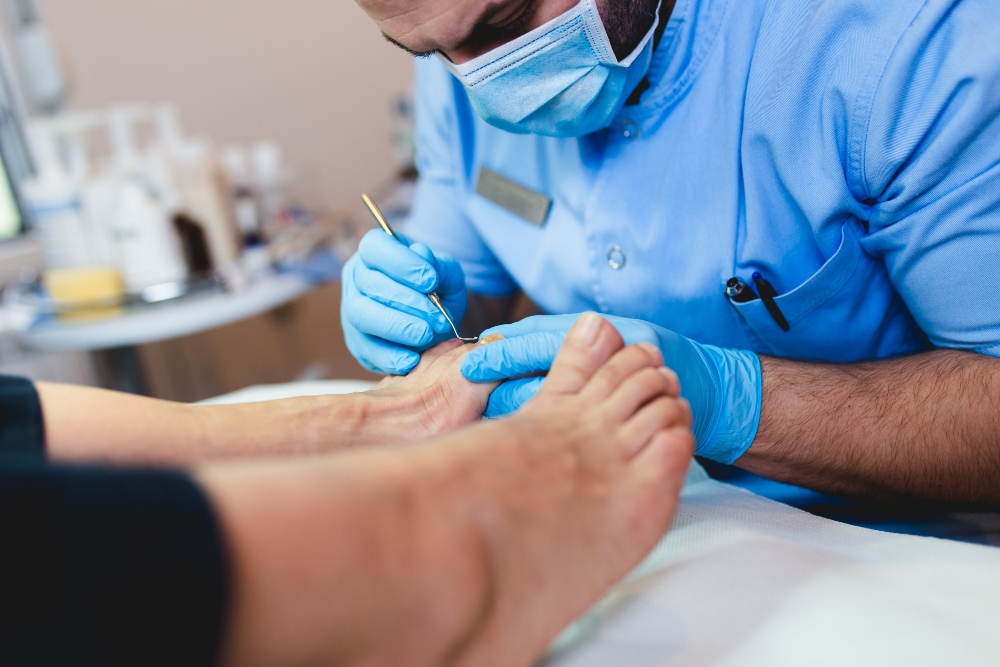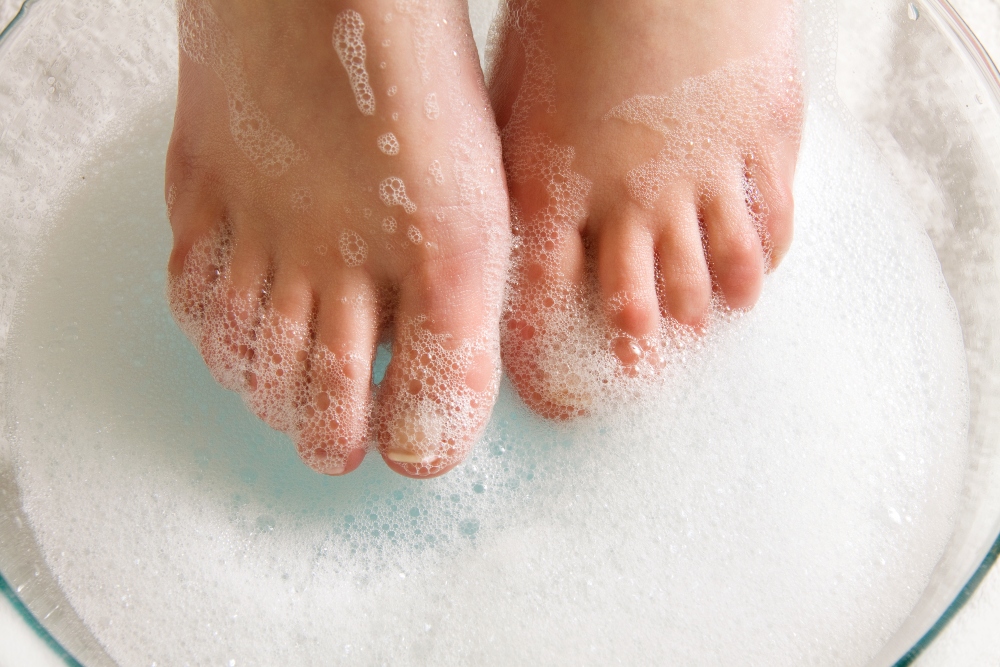Toe jam may have a funny name, but if you’ve ever noticed a sticky, smelly, or uncomfortable buildup between your toes, you know it’s no joke. These symptoms may be trying to warn you that you have an even bigger problem: a fungal or bacterial infection.

If you’re searching for what to do for toe jam, you’re in the right place.
But first, let’s clear up any confusion: toe jam and a jammed toe are not the same thing. Toe jam is a hygiene issue while a jammed toe is an injury that happens when the toe is stubbed or compressed.
If you’re wondering about the difference between a jammed toe vs. toe jam symptoms, we’ll cover both so you know how to treat each one.
What Is Toe Jam?
Despite its playful name, discovering something sticky, smelly, or flaky between your toes can be unsettling. Initially, you’ll wonder whether it’s normal and how to get rid of it.
The good news is that toe jam is rarely a serious medical condition, and its name is simply meant to describe the buildup of sweat, dead skin, bacteria, and debris in the spaces between your toes.
For most people, toe jam is just a nudge that it’s time for better foot hygiene.

What Does Toe Jam Look Like?
Toe jam looks different depending on its cause. It may look like a white, mushy substance caused by excess moisture, a waxy or flaky buildup due to dead skin, or even a thicker, sticky residue from sweat and dirt.
Most cases of toe jam are mild and rather harmless, but if you start to notice excessive buildup that leads to irritation, infections, or fungal growth, make an appointment or give us a quick call.
Symptoms of Toe Jam & When To Be Concerned
Toe jam tends to be rather harmless, but understanding the difference between normal and problematic symptoms can help you determine whether simple foot hygiene is enough or if a podiatrist should take a closer look.
If your toe jam is accompanied by pain, redness, swelling, or persistent odor, you may be facing other underlying issues such as:
- Fungal infection (Athlete’s Foot): If you notice itchiness, cracked skin, or peeling, a fungal infection could be to blame.
- Bacterial infection: Redness, swelling, and a strong odor may indicate bacteria have built up in the affected area.
- Excess moisture or maceration: White, overly soft skin that won’t dry properly can become a breeding ground for fungi and bacteria.
If you’re experiencing any of these symptoms, taking action before the problem worsens is important.
What Causes Toe Jam?
Toe jam may be common, but why does it happen in the first place?
Sweat & Poor Hygiene
Your feet contain thousands of sweat glands, and they naturally produce moisture throughout the day. If not properly washed and dried, sweat mixes with dead skin and debris, leading to buildup between the toes.
Fungal & Bacterial Growth
Warm, damp spaces, like the areas between your toes, are the perfect breeding ground for fungi and bacteria. This is why it’s important to keep your feet dry and practice proper hygiene, especially if you wear closed-toe shoes for long periods.
Tight or Non-Breathable Footwear
Wearing tight shoes or socks made from non-breathable materials can trap heat and moisture, increasing the risk of toe jam. Without proper airflow, sweat accumulates between the toes, creating the ideal environment for bacteria and fungus to thrive. Choose moisture-wicking socks and breathable shoes to help prevent excessive buildup.
Certain Medical Conditions
Some people are more prone to experiencing toe jam due to underlying conditions, such as:
- Hyperhidrosis (Excessive Sweating): People with hyperhidrosis deal with excessive foot sweating, which makes it harder to keep their feet dry.
- Diabetes: People with diabetes are at a higher risk of foot infections.
How To Prevent Toe Jam?
Since moisture and bacteria are the main culprits, keeping your feet clean, dry, and well-ventilated is the best way to prevent toe jam. If you frequently experience buildup or irritation between your toes, adjusting your hygiene routine and footwear choices will make a big difference.
Jammed Toe vs. Broken Toe Symptoms
While toe jam is a hygiene issue, some people searching for information may actually be dealing with a jammed toe, a minor injury caused by stubbing or overextending the toe.
Here’s how to tell the difference between a jammed toe vs. broken toe:
- Jammed Toe Symptoms: Swelling, bruising, stiffness, and mild discomfort that improves with rest.
- Broken Toe Symptoms: Severe pain, noticeable deformity, difficulty walking, and prolonged swelling or bruising.
If you suspect you have a broken toe, it’s best to seek medical attention rather than attempt home treatment.
Treatment for Jammed Toe vs. Toe Jam
If you’re dealing with toe jam, the good news is that it’s easy to treat. Since the main culprits are moisture, dead skin, and bacteria, the goal is to keep your feet dry and well-ventilated to prevent buildup.
Here’s how to get rid of toe jam and keep it from coming back.
Toe Jam Treatment
1. Wash & Dry Your Feet Daily
Wash your feet thoroughly with warm water and mild soap, making sure to clean between your toes. After washing, dry your feet completely, as lingering moisture can lead to fungal or bacterial growth.
2. Exfoliate to Remove Dead Skin & Debris
Use a gentle foot scrub, pumice stone, or exfoliating washcloth to slough away excess skin. Doing this one to two times a week can help reduce buildup and keep your toes fresh and clean.
3. Keep Moisture Under Control
Since damp environments encourage bacteria and fungi to grow, keeping your feet dry is important.
- Use antifungal powders or sprays to absorb excess moisture and prevent fungal infections.
- Choose moisture-wicking socks made from breathable fabrics like cotton or bamboo to keep sweat at bay.
- Change socks throughout the day if your feet tend to sweat a lot.
4. Upgrade Your Footwear
Wearing the wrong shoes can trap heat and moisture, making toe jam worse. To improve airflow and reduce sweat buildup
- Avoid tight or non-breathable shoes, which prevent air circulation.
- Opt for shoes made from breathable materials like mesh or leather.
- Use supportive insoles or orthotics to promote better airflow and reduce friction. Powerstep offers a variety of orthotic solutions that can help keep your feet dry and comfortable.

Treatment for Jammed Toe or a Broken Toe
Proper treatment depends on the severity of the injury; mild cases can heal with rest, while fractures may require medical attention.
When To See a Podiatrist
If your toe jam doesn’t go away with regular washing and drying, or if you notice any of the following symptoms, it’s time to consult a podiatrist:
- Pain, redness, or swelling that worsens.
- Persistent itching or peeling skin, which could indicate a fungal infection.
- A foul odor that doesn’t improve despite proper hygiene.
- Thickened, hardened skin that could be linked to corns or calluses.
- Recurring infections or skin breakdown, especially for people with diabetes.
If you’re suffering from these symptoms make an appointment or give us a call today at 239-936-5400.
Categorized in: Blog